Bolivia’s Wrestling Cholitas
Fronting a fierce spectacle of body-slamming, bowler hats and petticoats, Bolivia’s wrestling women have not only been winning fans around the region but also changing the conversation on equality in the country, as Sarah Gilbert discovers.
In a blur of red lamé, frilly petticoats and flying pigtails, La Gloria bounces off the ropes, lunges at the retreating back of her opponent and grips his neck with her thighs. He hits the canvas with a resounding thud, landing in an ungainly sprawl.
“Are you afraid?” she cries, as she rests her dainty foot on the back of his head, raising her arms triumphantly to an ecstatic audience.
I’d already watched an ageing but still muscular Mr Atlas, underpants over his tights, take on a fearsome-looking Crow. Then a handsome Aladdin floored The Devil, with help from the 75-year-old referee Ali Farak, as the crowd chucked half-chewed chicken bones and popcorn in their direction, accompanied by jeers and cries of ‘cheaters’.
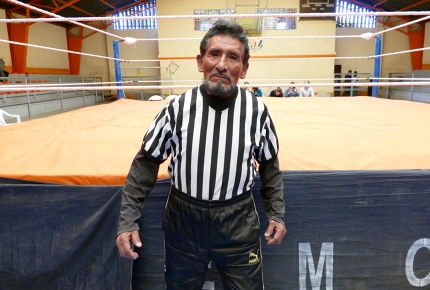 75-year-old wrestling referee Ali Farak
75-year-old wrestling referee Ali FarakSarah Gilbert
Finally, over ear-splitting music, foot stamping and impatient whistles, the compère bellowed dramatically into the microphone, the curtains leading to the backstage parted and La Gloria sashayed towards the ring to the biggest cheer of the day.
“Let’s dance!” she shouted, putting her bowler hat, fringed shawl and dangly earrings to one side. Within seconds of the bell, La Gloria and La Muerte – or Death – were locked in a high-octane bout, filled with athletic somersaults, flying fists and hair pulling.
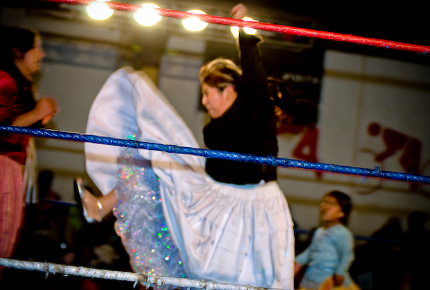 Can you smell what this cholita is cooking?
Can you smell what this cholita is cooking?Creative Commons / Joel Alvarez
Inspired by the masked wrestlers of Mexico’s lucha libre and the WWF Superstars in the US, Bolivia’s highly stylised take on wrestling is a theatrical mix of acrobatics, cartoon violence and old fashioned battles between goodies and baddies. It’s one-of-a-kind twist? Many of the wrestlers are cholitas, or the country’s indigenous Aymara women.
Bowler hats and pigtails
Cholitas certainly stand out, with bowler hats balanced at an improbable angle, pigtails hanging down their backs and flouncy polleras – full, multi-layered skirts. While the term chola is considered derogatory, synonymous with the country’s lowest social class, the word cholita has begun to have a positive overtone and signifies a woman who’s tough, resourceful and independent.
Each wrestling cholita has her own story. Following her whole family – father, mother and five siblings – into the ring, the diminutive Maria del Carmen Averanga started fighting in 2002, and when she dons her mini pollera, she transforms into the deceptively sweet Cholita Marina, who can execute a mean half-nelson.
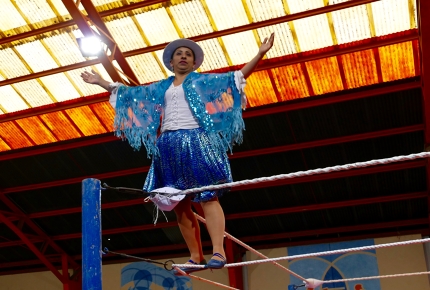 Cholita Marina after beating La Muerte (death)
Cholita Marina after beating La Muerte (death)Sarah Gilbert
“When I’m in the ring, hearing the audience scream and shout, I still get an adrenaline rush,” she explains. “I do it for love, it’s in my blood.”
While the show is pure theatre, the effort and the injuries from the wince-inducing falls are very real.
“In Bolivia it’s not considered a sport like it is in Mexico but I train three days a week in the gym and every Saturday in the ring,” Maria tells me.
“Every bit of my body hurts,” she says, before showing me a fading surgical scar on her throat, the result of an opponent stepping too hard on her neck.
But she doesn’t believe in limits for women. “Often we can be more athletic than men and I want to show the public that we are able to fight just as well, even in skirts.”
Witches’ market and colonial churches
The Sunday afternoon action takes place in the ever-growing city of El Alto, perched on a breathtakingly high plateau 4,000m above sea level to the north of lofty La Paz.
There are few cities with as extraordinary a setting as Bolivia’s high-altitude de facto capital, where there’s everything from a witches’ market to colonial churches, food stalls to cool cafés, bowler-hatted cholitas to hipsters on its often-chaotic streets.
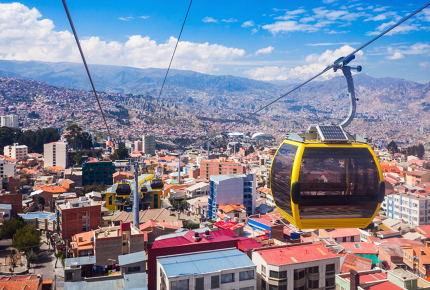 The cable car that links neighbouring cities La Paz and El Alto
The cable car that links neighbouring cities La Paz and El Altosaiko3p / Thinkstock
Now Mi Teleférico, the world’s longest and highest urban cable car network, makes it easier to get around and the red line to El Alto will give you a bird’s eye-view over the city and the glacier-tipped Cordillera Real, as well as dropping you at the colossal Sunday market, said to be the largest in Latin America.
Life can be tough in the ever-expanding sprawl of low-rise red brick houses, built by the rural poor escaping an even tougher life in the countryside. So for men, women and children, the wrestling – set in a cavernous concrete stadium with tiered wooden benches for the locals and VIP plastic seats around the ring for tourists – is a break from the daily grind.
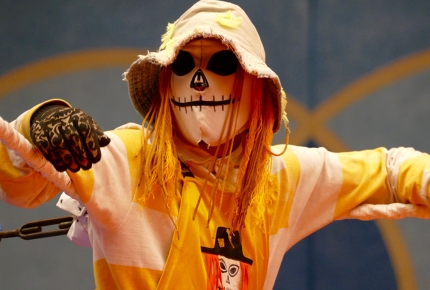 The Crow
The CrowSarah Gilbert
Virginia is a cholita from El Alto who takes her children to watch the wrestling every week. “I feel proud of the cholitas. They’re funny and entertaining and I like to study their technique, especially when they beat up the men,” she tells me.
She laughs as she says that, but domestic violence is a big problem in Bolivia. In a 2013 report that surveyed 12 Latin American and Caribbean countries, 53% of Bolivian women reported experiencing physical or sexual violence at the hands of a partner. So it’s more than mere entertainment in the ring; women are shown as powerful in a male-dominated culture.
And after years of double discrimination, indigenous women are becoming more prominent in political and professional spheres, as well as studying at university, with the pollera a show of pride in their heritage. It doesn’t always come cheap, however: a designer version of the cholita’s traditional outfit can cost up to US$10,000.
Increasing indigenous wealth is also changing the El Alto landscape, with fantastical, high-rise cholets (large houses) springing up, designed by Aymara architect Freddy Mamani Silvestre and with gaudy facades that mix Andean cosmic vision with Art Deco.
While the pay for cholita wrestling is often low, it empowers the women by giving them some financial independence. And some veteran wrestlers have achieved celebrity status in Bolivia.
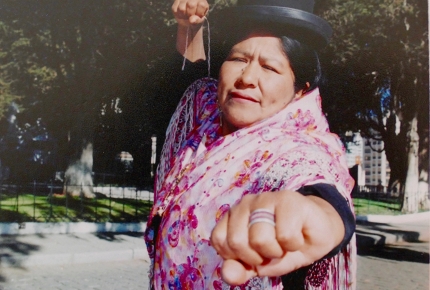 Carmen Rosa or La Campeona (the champion)
Carmen Rosa or La Campeona (the champion)Sarah Gilbert
The pioneering Polonia Ana Choque Silvestre – better known as Carmen Rosa, La Campeona, or The Champion – started wrestling in 2001, inspired by her passion for Mexico’s lucha libre. She was the first woman to fight in a pollera. Now she appears on television in Bailando por un Sueño, the Bolivian take on Strictly Come Dancing, and represents her sport internationally, with tours in Latin America, the US and the UK.
“They thought we should be in the kitchen, not in the ring."
“It wasn’t easy when I started fighting, as there was a lot of machismo. The male wrestlers discriminated against the women,” she explains. “They even tried to hurt and humiliate us so we would give up. But it made us stronger, not just physically but mentally, and eventually we gained their respect.”
“They thought we should be in the kitchen, not in the ring. That we couldn’t fight, especially in a pollera. It’s been a long struggle and there’s still discrimination but we’ve shown that a woman can do whatever she puts her mind to,” the feisty cholita tells me.
“And today we’re not just wrestlers, we’ve become an iconic part of Bolivian popular culture and anyone who hasn’t seen a cholita in the ring hasn’t experienced Bolivia.”
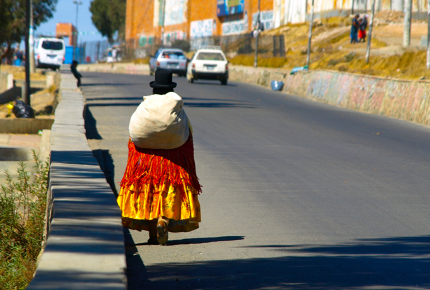 A cholita walking along the streets of El Alto
A cholita walking along the streets of El AltoPytyCzech / Thinkstock
NEED TO KNOW
Wrestling shows take place every Sunday afternoon at the Multifuncional de la Ceja de El Alto in La Paz, tickets cost 50 Bolivian Boliviano (£6).
Aracari (tel: 020 7097 1750, www.aracari.com) offer a four-day trip to La Paz from £1,000 per person, based on two sharing. This trip includes B&B accommodation at Atix Hotel, transfers, private guides and tours, including the wrestling cholitas. Aracari can also arrange private matches with Carmen Rosa on request.
American Airlines (www.aa.com) fly direct to Bolivia from Miami, while Air Europa (www.aireuropa.com) operate a direct route from Madrid. There are no direct flights to Bolivia from the UK at present; LATAM Airlines (www.latam.com) and Iberia (www.iberia.com) both offer indirect flights from the UK to the Bolivian cities of La Paz and Santa Cruz.
Do you have any Feedback about this page?
© 2026 Columbus Travel Media Ltd. All rights reserved. No part of this site may be reproduced without our written permission, click here for information on Columbus Content Solutions.









 You know where
You know where